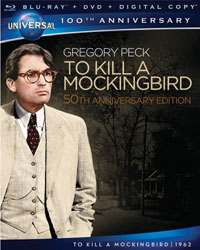 TO KILL A MOCKINGBIRD
TO KILL A MOCKINGBIRD
(not rated)
MOVIE: ***1/2 (out of 5)
BLU-RAY EXPERIENCE: **** (out of 5)
BY KEVIN CARR
Aside from it being mentioned in the two Truman Capote movies a few years back (which would be “Capote” and “Infamous”), I really hadn’t thought much about “To Kill a Mockingbird” since I was in high school. It was required reading for us in our American Literature class, and they also showed us the movie after we read the book.
“To Kill a Mockingbird” is a classic example of why forcing high school kids to read great American literature doesn’t always have the intended effect. I fiercely hated the book in high school (not as much as I hated “Catcher in the Rye,” but close). And making us watch the VHS of the movie on a 19-inch television from the back of a classroom was a bore.
As an adult, however, coming at the movie with a fresh eye and 24 more years of life under my belt, it was a different story. Ironically, this movie was required viewing for me because it was sent to me for review. However, I could appreciate it so much more. It also helps to have come to the movie with my innocence long-since shattered rather than my blissfully ignorant days of being a sixteen-year-old suburban kid whose greatest worry was whether I’d have enough walking-around money to buy my next batch of comic books.
Based on Harper Lee’s classic novel, “To Kill a Mockingbird” tells the story of two children, Scout and Jem, who live with their widowed father in the south during the Depression. Their father Atticus (Gregory Peck) is a lawyer in town who has been chosen to defend a young black man accused of rape. As the trial looms and the townsfolk attempt to enact street justice against the accused, Atticus stands fast to do the right thing, both legally and ethically.
There’s a lot of things happening in the movie, though not as complex as the novel. One of the greater themes is the loss of innocence, which we see from Scout’s point of view. Over the course of the trial, they see their father fighting against injustice and not always winning the fight. There’s also the revelation of gross racial injustice and the power of slanderous rumors against their reclusive neighbor Boo Radley.
I got so much more from this story as an adult, and it’s a shame that my adolescent stubbornness kept me from the movie for so many years. I’m glad I’ve seen it again in a better light and with a more mature head.
As part of Universal’s celebration of 100 years as a studio, this movie has been released in digitally remastered and restored Blu-ray high definition. For the most part, the picture looks great, though the noise reduction on a few of the magnified shots don’t quite play right. Still, it’s a beautiful looking black and white film in high definition.
The Blu-ray comes bundled with the DVD in book packaging, which includes an introduction by Peck’s widow along with historic elements like script pages with Peck’s notes and promotional cards. The Blu-ray includes two feature-length bonus movies. “Fearful Symmetry” examines the making of the film, and “A Conversation with Gregory Peck” is a full-length documentary celebrating the actor.
Additional bonus features on the Blu-ray include Peck’s Oscar speech, him accepting his Lifetime Achievement Award from the AFI, an excerpt from the Academy’s tribute to Peck, a 1999 interview with Scout actress Mary Badham, the theatrical trailer, an audio commentary and a look at the restoration process.
